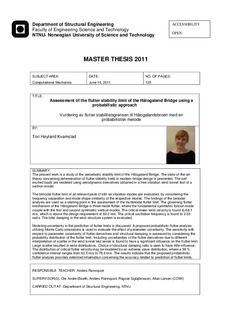Assessment of the flutter stability limit of the Hålogaland Bridge using aprobabilistic approach
Master thesis
Permanent lenke
http://hdl.handle.net/11250/236896Utgivelsesdato
2011Metadata
Vis full innførselSamlinger
Sammendrag
The present work is a study of the aeroelastic stability limit of the Hålogaland Bridge. The state-of-the-art theory concerning determination of flutter stability limits in modern bridge design is presented. The self-excited loads are modeled using aerodynamic derivatives obtained in a free vibration wind tunnel test of a section model.
The bimodal flutter limit of all relevant mode pairs are evaluated, by considering frequency separation and mode shape similarity of the respective modes. The findings of the bimodal analysis are used as a starting point in the assessment of the multimodal flutter limit. The governing flutter mechanism of the Hålogaland Bridge is three-mode flutter, where the fundamental symmetric torsion mode couple with the first and second symmetric vertical modes. The critical mean wind velocity is found to 68.1 m/s, which is above the design requirement of 60.2m/s. The critical oscillation frequency is found to 2.03 rad/s. The development of the total damping in the system with respect to increasing mean wind velocity is evaluated. Horizontal mode influence is investigated by applying quasi-static theory and aerodynamic derivatives obtained in the discrete vortex shedding software DVMFLOW. The results indicate that horizontal modes do not have influence on the flutter limit.
Modeling uncertainty in the prediction of flutter limits is discussed. A proposed probabilistic flutter analysis utilizing Monte Carlo simulations is used to evaluate the effect of parameter uncertainty. The sensitivity with respect to parameter uncertainty of flutter derivatives and structural damping is assessed by considering the probability distribution of the flutter limit. Including uncertainties of the flutter derivatives due to different interpretation of scatter in the wind tunnel test series is found to have a significant influence on the flutter limit.Large scatter resulted in wide distributions. Choice of structural damping ratio is seen to have little influence. The distribution of critical flutter velocity maybe modeled by an extreme value distribution, where a 99 % confidence interval ranges from 63.5 m/s to 78.6 m/s. The results indicate that the proposed probabilisticflutter analysis provides extended information concerning the accuracy in the prediction of flutter limits.
